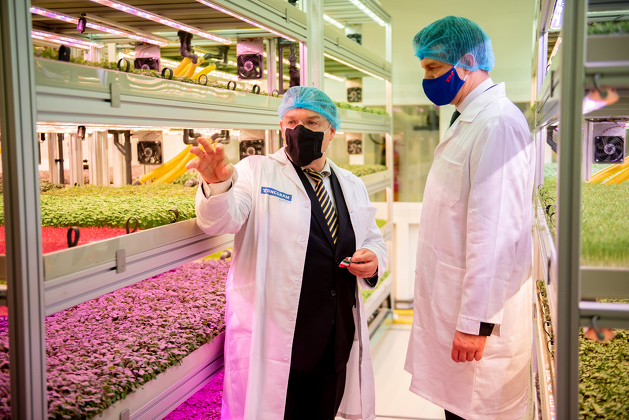An R&D purpose vertical farm unique in Central Europe was presented in the Újpest headquarters of Tungsram.
The installation, which is based on technology evoking sci-fi movies, is one of the key factors for the food security of the future. The farm was established with the funding of the Hungarian Ministry for Innovation and Technology (ITM) and inaugurated by State Secretary László György and President & CEO of Tungsram Joerg Bauer.
The vertical farm of Tungsram in Budapest was partly financed by the Ministry for Innovation and Technology in the framework of the project called “Indoor agriculture – setting up a vertical farm”.
The production area of the farm is 150 square meters where in a hydroponic system microgreens and baby leaves are grown exclusively under artificial, LED lighting regardless of the time of day or weather. While it is commercial size the focus of the facility is R&D which makes it unique in Central Europe. The area is complemented by two smaller growth chambers where the research activity takes place and the company utilizes the results achieved here on the commercial size farm.

“The cost of the development was 575 M HUF; 43,7% of which, 250 M HUF was financed by ITM. The farm is 100% Hungarian developed and produced”, said State Secretary of ITM László György on the ceremony. The farm was realized by KÉSZ Group, with the commercial partnership of Eisberg and using the biotechnology know-how of Biopólus Zrt. The lamps and technology were provided by the Nagykanizsa and Hajdúböszörmény plants of Tungsram. “Currently the facility provides work for 9 people, mainly researchers thus vertical farms will offer new, value-added job opportunities nation-wide.”, added the State Secretary. “The goal is Hungary to claim back its original position in the five biggest agricultural research countries based on its knowledge.”

Tungsram can show the entire technology and the result of it (quantity, colour, taste of plants) for future customers as the main goal is to sell and build similar, complete farm systems for other growers.
The company has ties with several Hungarian universities and plans to further expand these relationships. During the negotiations even the idea of a university faculty outsourced to a Tungsram plant was brought up as this technology is worth being naturalised in Hungary and introduced to the experts of the future. Tungsram’s lamps for indoor farming are already being tested in the Dutch horticulture giant University of Wageningen, University of Reading in the UK or the Fraunhofer Institute known for its standard certificates.

What are vertical farms good for?
In the case of indoor farming including vertical farms only artificial lighting is used (as opposed to greenhouses) thus one can grow plants year-round, day and night, in a small space, regardless of the climate, even in an urban environment. A controlled media is created which provides a sharp rise regarding the yield, quality, content value, water usage of crops compared to traditional agriculture. “As it does not depend on weather and other natural factors, we don’t distinguish good and bad years. The year is always perfect”, said Agritech Director of Tungsram Zoltán Sejpes.
This is an intense and currently costly technology that is especially competitive in four segments in the business sense:
- special vegetables (microgreens, baby leaves)
- plants beneficial for the pharmaceutical industry; those from which essential oils and essences can be extracted
- seedlings for reproduction (for greenhouses or even outdoor farming)
- strawberry (the most consumed fruit in the world)
In vertical farming the plant is only given what is best for it. While growing neither pesticides nor genetic modification are used. Light is the alpha and the omega of indoor farming; the proliferation of LED technology has brought a revolution in greenhouse farming as it allows for energy-efficient lighting conditions similar to the Sun necessary for the growth of vegetables, fruits and herbs.

Through the closed technology hygiene is maximized thus germs stay away. Water usage can also be reduced by 95-98% compared to outdoor farming and by this, a much higher productivity can be achieved than outside.
Food security of the future
„Tungsram celebrates its 125th birthday this year and each employee has contributed to social development first with the electric lamp, later with radio and TV. This technology that can be one of the solutions for the global food security problem is the opportunity of our generation”, said Tungsram President & CEO Joerg Bauer. „One of the factors of growth is that in 10 years – because of climate change, urbanisation and population increase – the world will need to provide 50% more food than now. All while arable lands are drastically decreasing.” For this reason, indoor farming can serve as an alternative for the food security of the world, however, huge development is necessary to be able to mass produce grains, rice, corn this way.














